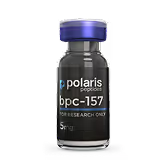Ipamorelin
Ipamorelin is a small five–amino-acid peptide that gently stimulates the ghrelin receptor to release growth hormone without affecting other hormones. When injected, it boosts GH pulses to support muscle repair and metabolism with minimal side effects. It’s used in research on growth-hormone therapies and aging.
Compound Overview
About the product
Ipamorelin’s sequence comprises five natural amino acids with an N-terminal formyl group and C-terminal amidation to enhance stability. No non-natural amino acids are incorporated beyond these terminal modifications. It is synthesized by Fmoc solid-phase peptide synthesis and purified by preparative HPLC to research-grade purity (>95 percent). Mass spectrometry confirms its correct molecular weight and sequence integrity.
Ipamorelin binds selectively to the ghrelin receptor on pituitary somatotrophs, triggering cyclic AMP–mediated GH release. It does not significantly stimulate release of cortisol or prolactin in human subjects. The peptide enhances both the amplitude and frequency of endogenous GH pulses. GH elevations are observed within 30–60 minutes of subcutaneous administration.
Ipamorelin benefits are studied primarily for their ability to raise natural GH levels with minimal off-target effects. In human trials, Ipamorelin produced significant increases in serum GH and sustained IGF-1 elevations compared with placebo. Subjects tolerated repeated dosing well, with no meaningful changes in cortisol or aldosterone. Research continues on its potential in age-related GH decline and muscle-wasting conditions.
Reported ipamorelin side effects in clinical studies have been mild and transient, most commonly injection-site discomfort and occasional headache. No significant changes in cortisol, prolactin, or glucose metabolism were documented. Long-term safety data beyond several weeks of use are lacking. Recommended monitoring includes serum GH/IGF-1 levels and basic metabolic panels.
Ipamorelin is produced by Fmoc solid-phase peptide synthesis on a resin support, incorporating the pentapeptide sequence with formylation and amidation. After cleavage, it is purified by preparative HPLC to exceed 95 percent purity. Mass spectrometry and HPLC confirm correct sequence and purity. Manufacturing follows research-grade peptide compounding standards.
Ipamorelin is classified for investigational research use only and is not approved by the U.S. FDA, EMA, or other major regulators for clinical therapy. It cannot be prescribed or sold as a medical treatment. Laboratories may obtain it under investigational-new-drug (IND) or equivalent frameworks. No clinical or over-the-counter products exist.
Ipamorelin dosage in human studies has typically ranged from 100 to 300 µg administered subcutaneously two to three times daily, often spaced 30 minutes before meals. Some protocols use once-daily dosing to assess GH pulse augmentation. No standardized dosing guidelines exist outside approved research protocols. All administration should follow institutional review–board-approved designs.
- Do restrict use to IRB-approved research protocols with medical oversight.
- Do monitor serum GH, IGF-1, and basic metabolic panels during treatment.
- Don’t combine with other GH secretagogues or exogenous GH without justification.
- Don’t use during pregnancy, lactation, or active malignancy.
- Q: How quickly does GH increase?
- A: GH peaks within 30–60 minutes after injection.
- Q: Does it affect other hormones?
- A: It does not significantly raise cortisol or prolactin.
- Q: Can it be used once daily?
- A: Some studies evaluate once-daily dosing, but most use multiple doses for pulse enhancement.
For research use only. Not approved for medical use.


